| Most
of my conceptual work in architecture during the 1970s
was focused on alternative solutions: mega-structures,
collaborative living environments, habitats designed
to generate their own heat, energy and food. |
| These
interests have never left me and, now, after two decades
of mostly building Management
Centers and NavCenters
for large organizations, it is time to return to these
interests. The necessary tools and technolgy now exist
- at last - for making these kinds of projects feasible
and wide spread. There are strong social, ecological
and economic arguments that can be made on their behalf. |
| The
central theme behind all of these works is that human
habitats do not have to be in conflict with “nature”
and that it is possible to house all of humankind in
conformable, self-sustaining, affordable environments.
It has been, and is, mostly a matter of design
- not intrinsically the nature or limits of technology
and economics. The present condition is, however, strongly
driven by “UpSideDown
Economics” and the various attitudes
and habits associated with this paradigm.
The entire arena of development
has to be rethought. |
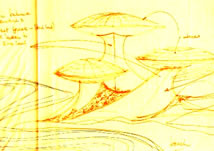 |
| People
are drawn to the sea. Yet, over use is destructive
to this changing habitat. Can we make a balance?
We must and do not have to give anything up but bad design. |
|
| Beach
MegaCity
- 1973 - is one of several “city in a building”
projects that safely provide a dense urban environment
in open and ecologically sensitive areas. I found the
economics and land-use aspects of these designs compelling
- and still do. With modern materials engineering and
energy/waste recycling technologies, these design can
provide density and open space, a high standard of living
and minimal ecological impact. Imagine a work with the
mechanics of a ship, the structure of an airplane and
the space of a covered stadium standing in “isolation”
in a natural wilderness. Imaging this structure providing
more personal cubic space per individual than any common
“flat-land” dwelling/working type does today.
Imagine the ability to access thousands of people and
hundreds of facilities in a matter of minutes. Imagine
being a few footsteps away from a pristine natural habitat
that was maintained as such. Imagine this at a total
cost far less than the system-in-place imposes today.
The issue, of course, will be to minimize the access
to the beach and dune areas so that damage is always
less than the restorative powers of the natural landscape.
Many will not like this; but think of the alternatives.
There will be three defined ones: the human, the interface
areas and the natural to be left totally untouched.
By doing this, and designing both development and access
accordingly, far greater use than is “enjoyed”
today can be accomplished with far greater sustainability. |
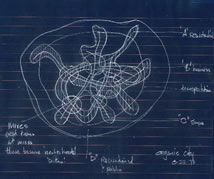 |
| This
layout makes full use of “ribbon streets”
(each a zone) and NODE organization (each
a hub of several zones crossing, creating an urban
“hot spot” and connecting vertically
to others. |
|
Organic
City - 1975 - is
a schema designed to integrate two opposing zoning
principles: single use and mixed use. These two approaches
each have some value. Actually, I am for mixed use
with pockets of single use. A mega structure is an
ideal Armature for innovation in both zoning and travel.
A new world of access and density opens up while still
accomplishing oneness and non crowding. “Ribbons
of single zoned areas “wander” their way
through the mega structure crossing at “mixed
use” intersections (Nodes). These intersections
are also vertical access lifts. Each vertical lift
goes to succeeding mixed use areas of different character.
On the horizontal plane, the various ribbons form
both transportation corridors and extended neighborhoods.
An infinate number of layouts can be accomplished
with this approach. The greatest value of a mega structure
can be realized: density with open space
|
| Depending
on scale and size, every mega structure shown on this
document can employ this schema to some extent with
good results. |
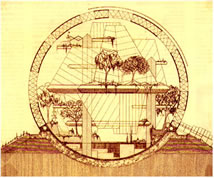 |
| Individual
wealth and lifestyle are in consort with commonwealth
and community in a nearly self-contained environment
that acts a an interface between humans and their
environment. |
|
DomicileOne
- 1975 - is an urban environment for several families.
I first worked the concept in 1967.
The economics are such that families can easily double
their standard of living while halving their living
costs - and at the same time - rebuild community
an an integral part of their life. Unitizing the “wick
effect” with it's double shell construction and
heat sink, this building will never freeze and can
be heated and cooled by largely passive means supplemented
by fuel cells. Here, economy, ecology and freedom
of lifestyle meet in harmony.
|
My
Bay
Area Studio design is much like the interior areas
of this project without the dome shell.
|
| The
basic forms of our urban layouts and building
structures impose huge “hidden”
economic and ecological costs. We create intrinsically
costly, inconvenient, unhealthy and dangerous architecture
and then re-spend the money in futile attempts to overcome
the deficiencies we built in. The problems associated
with transportation demand and use are tightly connected
to this process of sub-optimization. We do not see building
as EARTHSHIPS and we do not see vehicles as environments
that move. |
| Our
work spaces, homes and city infrastructures are not
designed based on an intrinsically solid financial
foundation. Financial analysis is performed on the pieces
without knowing that the system is wasting huge amounts
of present capital and future value. |
 |
| This
is the one that got away. A decade of explorations
rolled up into one project and then lost. |
|
| Steinmeyer
Residence - 1976 - was a commission that nearly
got built. It was my first design for a totally self-contained
environment. It the end, it proved too much for the
client. Emery Lovins executed his house at the Rocky
Mountain Institute, Snowmass, Colorado, in the early
80s. His project demonstrated the feasibility of this
approach in a far harsher climate than Kansas City where
the Steinmeyer project would have been realized. |
| Everything
in its season. |
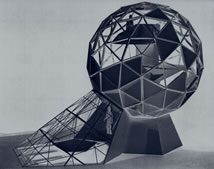 |
| I
have been developing this configuration since
the late 60s. It showed up in several sketches
in the 70s - Laura Powers developed this version for a Master design class in 1979. |
|
| EcoSphere
- 1978/79 - is a single-family dwelling - on the order
of a summer
cottage - that can be moved in 100 pieces and set
up almost anywhere. The large greenhouse is for energy
production and food. The pedestal houses storage and
waste cycling and energy generation equipment. A large
and varied living environment is accomplished on a small
footprint and temporary wood foundations. EcoSphere
is designed to be erected (and taken down) in a day
or two with little disturbance to the surrounding environment.
This configuration is one of several
uses that I explored with the geodesic dome. |
| The
geodesic Dome, invented my Bucky Fuller, has not been
fully utilized in the way that he envisioned. There
are several challenges
that are intrinsic to the domes basic shape that give
it great potential and significant potential liabilities.
Few built examples can be found - on the scale of a
single-family dwelling - that deal successfully with
both these design challenges. Like many new technologies,
architecture is yet to find the pattern-language appropriate
to them. |
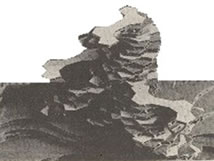 |
| Almost
unlimited diversity accomplished with a simple
geometric schema that lends itself to easy prefabrication to support all the functions of living. |
|
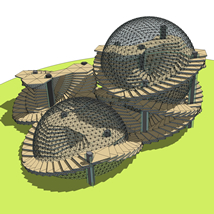 |
| combining the geodesic dome with the helix configuration, in this 2012 study, creates a half mile high city. Shown here is just the Armature structure. This structure will be filled and covered with “building” pathways and landscaping. |
|
| Helix
Mega City - 1978 - is organized on the three dimensional
interweaving zones schema of Organic City, (see
above). The layout of the helix city is a golden mean
rectangle connected to a hexagon which is connected
to a pentagon shape (at both ends of the rectangle).
Each level of this basic platform is offset about 7
degrees. The entire form spirals upward in a helix like
pattern. Using “left-hand” and “right-hand,
a “double helix can be created. The resulting shape
provides a strong structure and a variety of exposures
useful for a wide number of uses. |
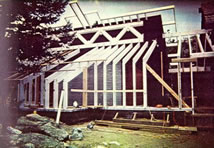 |
| The
Instead addition was connected to the existing
mountain cabin by a greenhouse designed to enclose
edible plants, a heat-sink and hot tub. |
|
| Instead
- 1980 - was a project that Gail and I started, in the
mountains above Boulder, Colorado, in 1980. It employed
many of the ideas that I had been working on throughout
the decade (and, specifically, EcoSphere): double-shell/wick-effect
natural cooling and heating, integrated greenhouse,
wood foundations and prefabricated components. Unfortunately,
this project was never finished as intended. Double
digit inflation killed the take-out mortgage at the
same time that we were self-financing the startup of
MG Taylor. When Acacia acquired our business and moved
us to Washington DC, they bought the house and sold
it, unfinished. The good news is that a very nice couple,
taking advantage of the low price, bought the property
and finished the project. This has resulted in a great
deal of compromise of the original intent as they were
not given my name and could not find out what was the
intent - apparently, they were not even given the drawings.
However, they finished it off “mountain-style”
and, while lacking technical acumen, made a very nice
home of it. |
|
| The
false “either/or” dichotomy of human habitat
versus natural habitat, urban density as apposed to
open spaces, easy access to people and resources versus
non-crowding, convenience and urban action versus simplicity
and economy - disappear when all of these values are
embraced as a legitimate aspect of one design process. |
| All
of these environments explored in this period, by the
nature of their configuration, require new approaches
to their layouts, definition and use of space. For one,
designers have to think 3 dimensionally - not flat.
Many of the qualities
that we have accomplished in Management Centers, over
the last 20 years, demonstrate these spatial opportunities.
The MegaCity, however, can accomplish these Pattern-Language
principles - particularly in the vertical dimension
- in an unprecedented way and at an unprecedented scale. |
| Architect
Paolo Soleri has pioneered many of these ideas and started
the development of a new city-form with his Arcosanti
project in Arizona. |
| Generally,
there has been great resistance to MegaCity concepts.
When one looks at the typical large building and urban
setting, and how there works are executed, it is easy
to see why. We have to remember, however, that we are
building MegaCities now - we are just doing it poorly.
We are making vast “peanut-butter-spread”
cities with no center, no rhyme or reason. The MegaCity
premise has been granted by default - not by design.
In addition, the growing infrastructure that is tying
our urban centers together and the production of suburban
sprawl means that that, shortly, the entire earth will
be a human
artifact. An artifact by accident. |
| We
can do better. These 1970s concepts explore some design
patterns that have promise for today and for the future. This was the architecture
I explored as I was rethinking my entire concept of
the future and our human role in it [link: a future by...]. It was with these
projects that the social aspects of architecure came
into my thinking. 30 years later, Gaia
waits, we are still without a concept of Planetary Architecture [link: planetary architecture] and there is no Master Planning process in place [link: master planning process]. |
|
Matt
Taylor
Palo Alto
February 21, 1999

SolutionBox
voice of this document:
VISION • STRATEGY • SCHEMATIC
|
|
click on graphic for explanation of SolutionBox |
posted:
February 21, 1999
revised:
December 9, 2002
• 20000521.231478.mt • 20010402.498763.mt •
•
20010403.377692.mt • 20021209.229887.mt •
• 201200128.3418762.mt •
(note:
this document is about 65% finished)
©Copyright
Matt Taylor 1973, 1975, 1996, 1978, 1999, 2000, 2001, 2002, 2012
|
|
|